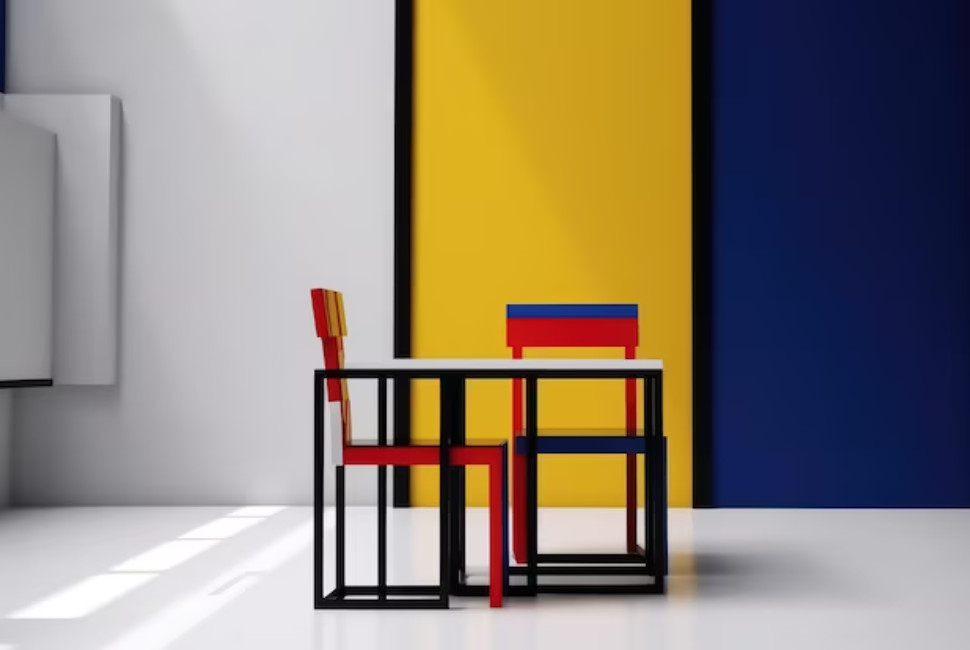If you have ever seen a painting composed of stark lines and primary colours, you might have encountered the world of De Stijl. Founded in the Netherlands in 1917, it became a ground-breaking art movement that forever changed the course of modern art. Piet Mondrian is its most famous representative, but he was far from alone.
Let’s dive into this fascinating movement, from its origins and key players to its enduring legacy.
The birth of De Stijl
World War I, a turbulent period in history, gave birth to the roots of De Stijl. It was a time of devastation and loss but also a period that stimulated introspection and the quest for a new societal order. A group of Dutch artists, led by Theo van Doesburg, felt compelled to contribute to this change through art. They envisioned a new kind of artistic expression that would reflect a unified, harmonious world.
Van Doesburg did not just initiate the movement. He also served as its primary spokesperson through a journal he published, also named ‘De Stijl.’ This journal was instrumental in broadcasting the movement’s principles in the Netherlands and Europe. They used geometric forms and a limited colour palette to create a visual language they hoped everyone could understand.
Who was the face of this art movement?
When people think of De Stijl, Piet Mondrian often comes to mind. Although he began his artistic career painting the natural world, he soon underwent a profound transformation. Driven by his philosophical studies and a passion for abstraction, he began simplifying his work. His well-known ‘Composition’ series set the standard for what De Stijl’s art should embody. It did more than gain Mondrian fame; it brought international attention to the entire De Stijl movement.
Today, Mondrian’s work is a focal point in significant art museums. It continues to inspire artists, designers, and even fashion icons.
Other key players
Mondrian was undoubtedly De Stijl’s leading figure but was part of a larger ensemble of creatives. Take Gerrit Rietveld, an architect and furniture designer who applied De Stijl’s principles in three dimensions. His Red and Blue Chair is a simple masterpiece, echoing Mondrian’s paintings’ geometric lines and primary colours.
Bart van der Leck and Vilmos Huszár were also instrumental figures. Van der Leck contributed significantly to the movement by using geometric shapes in painting. At the same time, Huszár made his mark in graphic design. He created logos and other visual materials steeped in De Stijl’s ideology.
De Stijl in architecture and design
The philosophy of De Stijl did not limit itself to canvas. It leapt off to influence architecture and design as well. Gerrit Rietveld’s Schroder House in Utrecht is a prime example of the movement’s architectural aspirations.
Unlike traditional homes with static interiors, the Schroder House features movable walls that create a dynamic living space. It encapsulates the ideals of De Stijl: geometric purity and primary colours in a utilitarian form. Besides architecture, De Stijl also left an indelible mark on graphic design, typography, and even the Bauhaus movement, affirming its multidisciplinary impact.
What about legacy and influence?
The tendrils of De Stijl’s influence extend far beyond its early 20th-century origins. You can see its aesthetic elements in the minimalist design approaches that dominate today’s web layouts and user interfaces. Simple shapes and lines from De Stijl appear in modern building designs, and its focus on essential elements inspires many artists today.
Moreover, institutions like the Museum of Modern Art in New York and the Tate Modern in London frequently organize exhibitions dedicated to De Stijl. This way, they attract new generations of art lovers and practitioners. Art schools worldwide include De Stijl in their curriculum. It ensures that the movement’s principles continue challenging and inspiring future artists.
Conclusion
De Stijl might have begun as a slight Dutch movement, but its ideas have reached every corner of the globe. Its emphasis on geometric shapes and primary colours has shaped art history and left its mark on architecture and design.
Are you interested in experiencing De Stijl for yourself? Take advantage of the next exhibition or lecture near you to explore this fascinating world of geometric abstraction.
